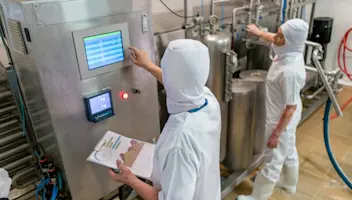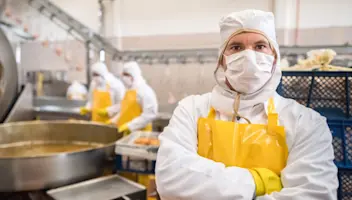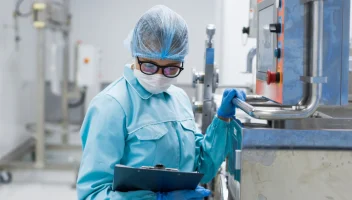4 Common Food and Beverage Facility Safety Concerns and How to Overcome Them
4 Common Food and Beverage Facility Safety Concerns and How to Overcome Them
4 Common Food and Beverage Facility Safety Concerns and How to Overcome Them
22 Févr 2022
John McCurdy
For a food and beverage professional like yourself, pressure comes from a number of sources. Your production and profitability targets are as high as ever, putting efficiency at a premium. Your customers demand nothing but the best, making quality assurance a top priority. And government regulations are growing more stringent all the time, so compliance is another matter of critical importance.
What can get lost in all of these operational considerations is your people and their well-being. You know that your employees are your greatest asset, but when you’re focused on achieving optimal business outcomes, you may find that you lack the time and resources to properly protect the people that keep your facilities running and products rolling off the line.
The statistics on food and beverage worker injuries are telling—according to environmental, health and safety (EHS) consulting firm Antea Group, 24% have been injured at their current job, and 17% were injured in their first year. Overall, food manufacturing has a 60% higher rate of occupational injury and illness as compared to other industries, painting a somewhat daunting picture.
In order to make sure that your staff can operate with confidence in a risk-free environment, you need to know the most common workplace safety mistakes and how to prevent them. Be they active hazards or latent liabilities, these should be the first four issues you address in your efforts to safeguard employees from potential harm.
Overall, food manufacturing has a 60% higher rate of occupational injury and illness as compared to other industries.
1. Inconsistent or Improper Use of Personal Protective Equipment (PPE)
In the age of the COVID-19 pandemic, we have all become aware of the necessity of face masks as PPE to prevent the transmission of airborne illnesses. That being said, in a fast-paced environment like that of a food and beverage production facility, it’s still all too common that forgetfulness or time pressure results in PPE either being improperly worn or altogether neglected.
One way to help increase the chances that your staff use the required PPE and affix it correctly is to place the equipment near the machinery or zones where it is necessary. Creating a “station” with all of the necessary gear, as well as illustrated instructions for its optimal use, is a great idea for those organizations struggling to increase compliance.
Constructive reinforcement from peers is another powerful force for encouraging consistent use of PPE, but we’ll cover that topic in greater depth in a later section.
2. Incomplete or Insufficient Training
Training your employees on how to protect themselves is no doubt crucial—after all, they’ve got to know what steps to take if they’re going to carry them out every day with regularity. Still, don’t underestimate the importance of conveying why they should follow your workplace safety protocols.
It makes sense that if a person is made aware of the potential negative consequences of inaction, they’ll be more likely to create good habits and routinely follow best practices. And when the stakes are as high as bodily harm, a strong impression can be made and have a lasting effect on behavior.
Showing images of gruesome injuries isn’t necessary—you don’t need to resort to “scare tactics” when dealing with professionals. When possible, you should also keep your instructional materials simple, as according to Antea Group some 37% of staff and 43% of supervisors at food and beverage businesses say that training can be too complicated or difficult to understand.
A good approach involves discussing accidents that have happened in the past and their ramifications, as well as those near-misses that have occurred. These conversations can have a profound impact on the value that your personnel place on your prescribed safety procedures.
Some 37% of staff and 43% of supervisors at food and beverage businesses say that training can be too complicated or difficult to understand.
3. Poor Ergonomics and Warehouse Layout
Food manufacturing workers often spend long periods of time interacting with machinery and terminals while either seated or standing. If you don’t design your workspaces to suit the people that use them, aches and pains can crop up as a result of inconvenient arrangements, poor lighting, difficult angles, repetitive motions and uncomfortable equipment.
While you certainly can’t reconstruct your facility for maximum ergonomic comfort, you may be able to improve upon what is in place. Frequently used walking paths should be clear of obstructions and as level as possible to avoid tripping hazards, and work areas should be bright—but not blindingly so. And the extra costs that go into purchasing well-cushioned chairs and padded anti-fatigue floor mats will be rewarded in the long run, as hours lost to injury will be significantly reduced.
Meanwhile, in your warehouse, the height and spacing of your shelves and bins should be scrutinized to determine whether they can be better configured for frequent access. A digital solution like our warehouse management system solution, Aptean Warehouse Management System (WMS), can help optimize your layout by analyzing patterns and identifying how the most commonly used picking locations should be situated for both efficiency and safety.
4. Lack of a Safety Culture
The least tangible “hazard” on our list might just be the most important. If you don’t make it clear that workplace safety is a company-wide commitment and actively encourage the values of accountability and prudence, then there’s little chance that your employees will take up the banner.
Instilling a culture of safety starts at the top with your C-suite executives, but your supervisors and managers will be among the most prominent advocates in practice. When they back up their words with actions, they empower each individual staff member to prioritize their own safety and encourage others to do the same.
Convey in no uncertain terms that no one needs to “take one for the team”—everyone’s health is equally valuable and worth protecting. And whether it’s reminding a coworker to put on their goggles before entering a dangerous area or calling attention to a slippery spill, everyone on the payroll has a part to play in conveying the significance of safety at your facility.
Facilitating a Sound Strategy with Technology
It’s pretty unlikely that you can make your food and beverage business a safer place to work overnight. However, if you’re aware of these issues and can implement some of the risk mitigation techniques we’ve mentioned, you should be able to better protect your people, keep avoidable injuries to a minimum and create the right culture.
Another way to accelerate your progress toward key safety-related goals is to modernize your facilities and systems with today’s technological solutions. An industry-specific enterprise resource planning (ERP) platform should act as the foundation of your digital transformation, as these solutions power holistic improvement across all areas of an organization.
Our purpose-built food and beverage offering, Aptean Food & Beverage ERP, comes with features out of the box that can make a real difference for the well-being of your personnel, including automatic scheduling of sanitation, preventative maintenance and safety audits. The system also offers robust analytics, so you can identify problems that need to be addressed and prevent emergencies before they occur.
Want to hear more about our food ERP and how it can help you establish better workplace safety? Contact us today or request a personalized demo.
Related Content





These 10 clients from across various food and beverage sectors achieved more with our solution.



